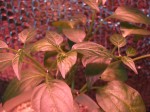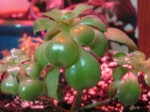Below 390nm we find UV which is harmful to plants at close distances. The peak for chlorophyll absorption falls within 390nm to 510nm- promoting strong, compact vegetative growth. From 520nm to 600nm is mainly white light pollution with little chlorophyll production. (These are the wavelengths the human eye is sensitive to, we perceive them as light.) The primary wavelengths used for photosynthesis fall between 600nm to 720nm. From 710 to 730 is the far red spectrum which promotes flowering. Beyond 730 is infrared heat; this is what makes HPS heat up to sometimes 1500 degrees at the bulbs surface. Adding IR to LEDs makes for a very short bulb life (heat is the enemy of LEDs).
A typical white light product produces light wavelengths from 380 nm (UV) up to and beyond 880 nm (IR). Plants, on the other hand, primarily use light wavelengths from 400 nm (blue) to 700 nm (red). This range of light wavelengths has been labeled PAR or photosynthetically active radiation. On average, nearly 82% of the light emitted from a traditional white light product is of little benefit to plant growth, and in some cases is harmful to plant health. In a typical HID, HPS, or MH light bulb this harmful energy is in the form of intense heat (IR) and ultraviolet radiation (UV) that you cannot see but can certainly feel.







